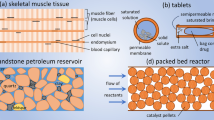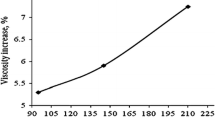Abstract
In this paper, we apply mixture theory to quantitatively predict the transient behavior of drug delivery by using a microneedle array inserted into tissue. In the framework of mixture theory, biological tissue is treated as a multi-phase fluid saturated porous medium, where the mathematical behavior of the tissue is characterized by the conservation equations of multi-phase models. Drug delivery by microneedle array imposes additional requirements on the simulation procedures, including drug absorption by the blood capillaries and tissue cells, as well as a moving interface along its flowing pathway. The contribution of this paper is to combine mixture theory with the moving mesh methods in modeling the transient behavior of drug delivery into tissue. Numerical simulations are provided to obtain drug concentration distributions into tissues and capillaries.
Similar content being viewed by others
References
Almeida ES, Spilker RL (1998) Finite element formulations for hyperelastic biphasic soft tissues. Comput Methods Appl Mech Eng 151(3–4): 513–538
Atkin RJ, Craine RE (1976) Continuum theories of mixtures: basic theory and historical development. Q J Mech Appl Math 29(2): 209–244
Brazzle J, Papautsky I, Frazier AB (1999) Micromachined needle arrays for drug delivery or fluid extraction. IEEE Eng Med Biol Mag 18(6): 53–58
Chandrasekaran S, Frazier AB (2003) Surface micromachined metallic microneedles. J Microelectromech Syst 12(3): 281–288
Chen JK, Wise KD (1994) A multichannel neural probe for selective chemical delivery at the cellular level. Solid State Sensor and Actuator Workshop, pp 256–259
Chen JK, Wise KD, Hetke JF et al (1997) A multichannel neural probe for selective chemical delivery at the cellular level. IEEE Trans Biomed Eng 44(8): 760–769
Davis S, Prausnitz M, Allen M (2003) Fabrication and characterization of laser micromachined hollow microneedles. In: Proceedings of transducers 03, international conference on solid-state sensors and actuators, pp 1435–1438
Davis SP, Landis BJ, Adams ZH et al (2004) Insertion of microneedles into skin: measurement and prediction of insertion force and needle fracture force. J Biomech 37(8): 1155–1163
Frauhammer J, Klein H, Eigenberger G, Nowak U (1998) Solving moving boundary problems with an adaptive moving grid method: Rotary heat exchangers with condensation and evaporation. Chem Eng Sci 53(19): 3393–3411
Gardeniers H, Berenschot E, De Boer M et al (2002) Silicon micromachined hollow microneedles for transdermal liquid transfer. MEMS 2002, pp 141–144
Gardeniers H, Luttge R, Berenschot E et al (2003) A silicon micromachined hollow microneedles for transdermal liquid transport. J Microelectromech Syst 12(6): 855–862
Griss P, Stemme G (2002) Novel, side opened out-of-plane microneedles for microfluidic transdermal interfacing. In: International conference on microelectromechanical systems (MEMS’02), pp 467–470
Griss P, Stemme G (2003) Side-opened out-of-plane microneedles for microfluidic transdermal liquid transfer. J Microelectromech Syst 12(3): 296–301
Henry S, Mcallister DV, Allen MG, Prausnitz MR (1998) Micromachined needles for the transdermal delivery of drugs. In: Proceedings of micro electro mechanical systems workshop (MEMS’98), pp 494–498
Holmes MH (1986) Finite deformation of soft tissue: analysis of a mixture model in uni-axial compression. J Biomech Eng 108(4): 372–381
Jain RK (1987) Transport of molecules in the tumor interstitium: a review. Cancer Res 47(12): 3039–3501
Kaushik S, Hord AH, Denson DD et al (2001) Lack of pain associated with microfabricated microneedles. Anesth Analg 92(2): 502–504
Kim K, Park D, Lu H et al (2004) A tapered hollow metallic microneedle array using backside exposure of SU-8. J Micromech Microeng 14(4): 597–603
Kuo SC, Chou Y (2004) A novel polymer microneedle arrays and PDMS micromolding technique. Tamkang J Sci Eng 7(2): 95–98
Kwan MK, Lai MW, Mow VC (1990) A finite deformation theory for cartilage and other soft hydrated connective tissues I. Equilibrium results. J Biomech 23(2): 145–155
Langer R (1998) Drug delivery and targeting. Nature 392(6679 Suppl): 5–10
Lian M, Islam N, Wu J (2007) AC electrothermal manipulation of conductive fluids and particles for lab-chip applications. IET Nanobiotechnol 1(3): 36–43
Lin LW, Pisano AP, Muller RS (1993) Silicon processed microneedles. In: Technical digest, 7th international conference on solid-state sensors and actuators, transducers, vol 93, pp 237–240
Lv YG, Liu J, Gao YH et al (2006) Modeling of transdermal drug delivery with a microneedle array. J Micromech Microeng 16(11): 2492–2501
Ma B, Gan Z, Liu S (2005) Flexible silicon microneedles array for micro fluid transfer. In: 6th International conference on electronic packaging technology, pp 561–565
Mills N (1966) Incompressible mixtures of Newtonian fluids. Int J Eng Sci 4(2): 97–112
Moon S, Lee S (2005) A novel fabrication method of a microneedle array using inclined deep X-ray exposure. J Micromech Microeng 15(5): 903–911
Morf WE, Guenat OT, de Rooij NF (2001) Partial electroosmotic pumping in complex capillary systems Part 1: principles and general theoretical approach. Sens Actuators B 72(3): 266–272
Mow VC et al (1980) Biphasic creep and stress relaxation of articular cartilage: theory and experiments. ASME J Biomech Eng 102(1): 73–84
Najafi K, Wise KD (1986) An implantable multielectrode array with on-chip signal processing. IEEE J Solid-State Circuits 21(6): 1035–1044
Najafi K, Wise KD, Mochizuki T (1985) A high-yield IC-compatible multichannel recording array. IEEE Trans Electron Devices 32(7): 1206–1211
Netti PA, Travascio F, Jain RK (2003) Coupled macromolecular transport and gel mechanics: poroviscoelastic approach. AICHE J 49(6): 1580–1596
Nicholson C, Phillips JM (1981) Ion diffusion modified by tortuosity and volume fraction in the extracellular environment of rat cerebellum. J Physiol 321: 225–257
Nield DA, Bejan A (1992) Convection in porous media. Springer, New York
Oomens CW, van Campen DH, Grootenboer HJ (1987) A mixture approach to the mechanics of skin. J Biomech 20(9): 877–885
Petzold LR (1987) Observations on an adaptive moving grid method for one-dimensional systems of partial differential equations. Appl Numer Math 3(4): 347–360
Prausnitz MR (2004) Microneedles for transdermal drug delivery. Adv Drug Deliv Rev 56(5): 581–587
Prausnitz MR, Mcallister DV, Kaushik S et al (1999) Microfabricated microneedles for transdermal drug delivery. ASME Bioeng Div 42: 89–90
Prausnitz MR, Mitragotri S, Langer R (2004) Current status and future potential of transdermal drug delivery. Nat Rev Drug Discov 3(2): 115–124
Reed ML, Lye WK (2004) Microsystems for drug and gene delivery. Proc IEEE 92(1): 56–75
Stoeber B, Liepmann D (2005) Arrays of hollow out-of-plane microneedles for drug delivery. J Microelectromech Syst 14(3): 472–479
Suh JK, Spilker RL, Holmes MH (1991) A penalty finite element analysis for nonlinear mechanics of biphasic hydrated soft tissue under large deformation. Int J Numer Methods Eng 32(7): 1411–1439
Zahn JD, Deshmukh A, Pisano AP et al (2004) Continuous on-chip micropumping for microneedle enhanced drug delivery. Biomed Microdevices 6(3): 183–190
Zhang P, Dalton C, Jullien GA (2009) Design and fabrication of MEMS-badsed microneedle arrays for medical applications. Microsyst Technol 15(7): 1073–1082
Author information
Authors and Affiliations
Corresponding author
Rights and permissions
About this article
Cite this article
Zhang, R., Zhang, P., Dalton, C. et al. Modeling of drug delivery into tissues with a microneedle array using mixture theory. Biomech Model Mechanobiol 9, 77–86 (2010). https://doi.org/10.1007/s10237-009-0160-7
Received:
Accepted:
Published:
Issue Date:
DOI: https://doi.org/10.1007/s10237-009-0160-7




